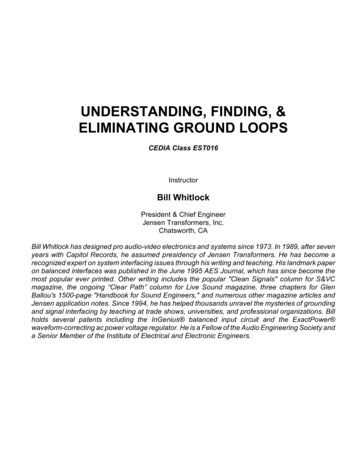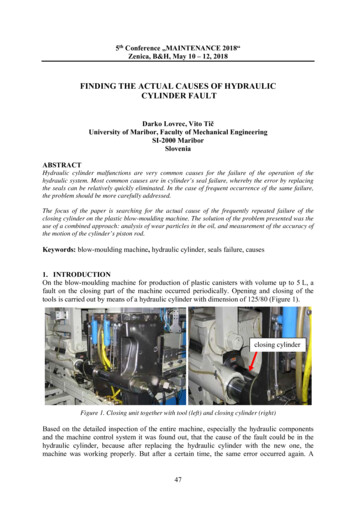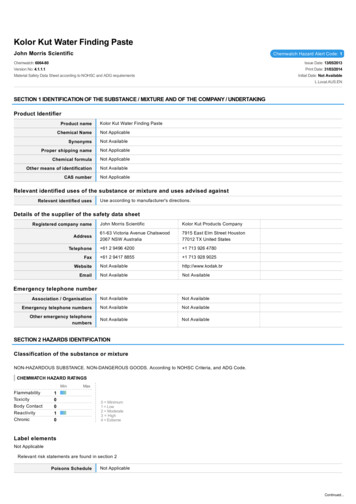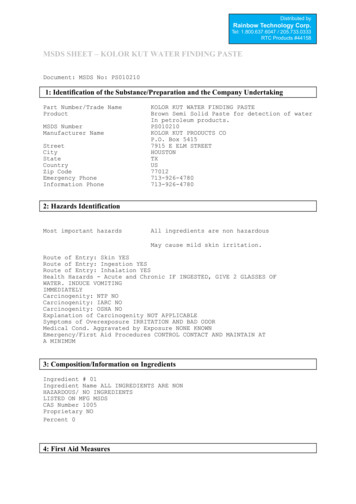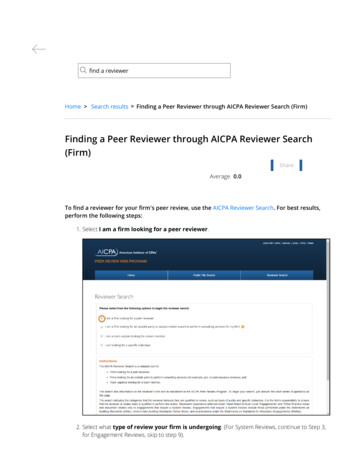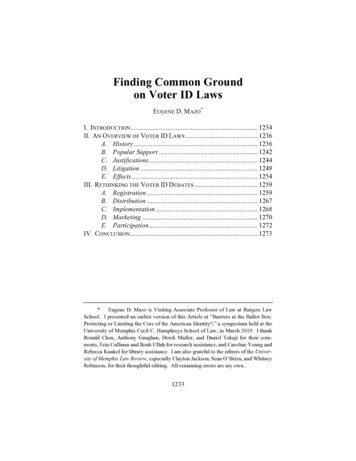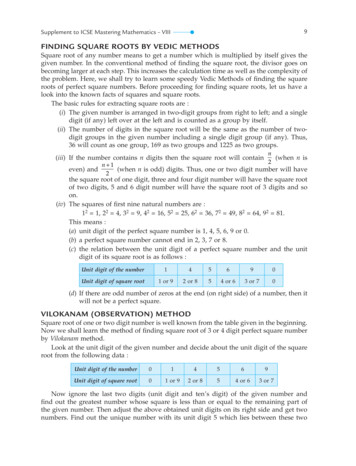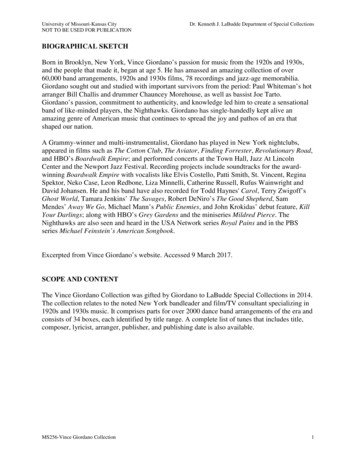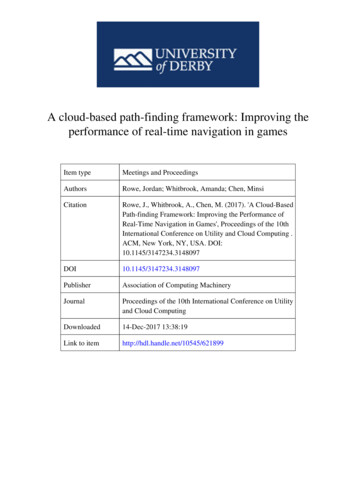
Transcription
A cloud-based path-finding framework: Improving theperformance of real-time navigation in gamesItem typeMeetings and ProceedingsAuthorsRowe, Jordan; Whitbrook, Amanda; Chen, MinsiCitationRowe, J., Whitbrook, A., Chen, M. (2017). 'A Cloud-BasedPath-finding Framework: Improving the Performance ofReal-Time Navigation in Games', Proceedings of the 10thInternational Conference on Utility and Cloud Computing .ACM, New York, NY, USA. 097PublisherAssociation of Computing MachineryJournalProceedings of the 10th International Conference on Utilityand Cloud ComputingDownloaded14-Dec-2017 13:38:19Link to itemhttp://hdl.handle.net/10545/621899
A Cloud-Based Path-finding Framework: Improving thePerformance of Real-Time Navigation in GamesJordan RoweAmanda Whitbrook Minsi ChenThrive Therapeutic SoftwareNottingham, UKmail@jordanneilrowe.co.ukDepartment of Electronics,Computing and MathematicsUniversity of DerbyDerby, UKa.whitbrook@derby.ac.ukSchool of Computing and EngineeringUniversity of HuddersfieldHuddersfield, UKm.chen@hud.ac.ukABSTRACTThis paper reviews current research in Cloud utilisation withingames and finds that there is little beyond Cloud gaming and CloudMMOs. To this end, a proof-of-concept Cloud-based Path-findingframework is introduced. This was developed to determine the practicality of relocating the computation for navigation problems fromconsumer-grade clients to powerful business-grade servers, withthe aim of improving performance. The results gathered suggestthat the solution might be impractical. However, because of thepoor quality of the data, the results are largely inconclusive. Thusrecommendations and questions for future research are posed.ACM Reference Format:Jordan Rowe, Amanda Whitbrook, and Minsi Chen. 2017. A Cloud-BasedPath-finding Framework: Improving the Performance of Real-Time Navigation in Games. In UCC ’17: 10th International Conference on Utility andCloud Computing Companion. ACM, New York, NY, USA, 5 pages. ONThe Cloud continues to be a focal point for research, yet there islimited literature available on the subject of Cloud utilisation withingames; existing research typically targets Cloud gaming and CloudMMOs. To this end, a proof-of-concept Cloud-based path-findingframework is proposed. This is a simple architecture, designed tocompute the navigation routes for computer-controlled agents inthe Cloud.A further motivation for its development is the need to increaseavailable resources to push the boundaries of game AI development,which is currently far from being able to outperform human experts[3], often as a result of a lack of memory. In addition, it is evidentthat real-time strategy (RTS) games are one of the more challenginggenres to develop intelligent navigation for. This is a direct result of CorrespondingauthorPermission to make digital or hard copies of all or part of this work for personal orclassroom use is granted without fee provided that copies are not made or distributedfor profit or commercial advantage and that copies bear this notice and the full citationon the first page. Copyrights for components of this work owned by others than ACMmust be honored. Abstracting with credit is permitted. To copy otherwise, or republish,to post on servers or to redistribute to lists, requires prior specific permission and/or afee. Request permissions from permissions@acm.org.UCC’17 Companion, December 5–8, 2017, Austin, TX, USA 2017 Association for Computing Machinery.ACM ISBN 978-1-4503-5195-9/17/12. . . 15.00https://doi.org/10.1145/3147234.3148097the tight constraints imposed, which include real-time and simultaneous moves, partial observability, nondeterministic play, and vaststate space sizes.The goal of this research is thus to evaluate the computationalbenefit of moving path-finding calculations from consumer-gradeclients to powerful business-grade servers and to determine whetherthere is a potential application for Cloud based path finding withinreal-time games, i.e. can the Cloud perform at an acceptable levelwhen the network bandwidth is assumed to be the largest variableaffecting performance? Note that henceforth this paper refers tothe server-computed path search as Cloud Path-finding, and anypaths computed on the client as Local Path-finding.1.1RTS AI ResearchThere is a multitude of research on RTS AI covering the followingtopics as categorised by [3, 12]: adversarial planning [9, 11, 15],opponent modeling [17], decision making under uncertainty [12],spatial and temporal reasoning [3, 5, 12], resource management[4, 10, 13], collaboration [3, 12] and path-finding [1, 2, 7, 14]. Despitethe diverse range of topics, none attempt to solve their problems using the Cloud, which provides additional rationale for the researchconducted.2RELATED WORKThe only existing literature that proposes a concept similar to CloudAI is [18]. This paper introduced the notion of a fast and scalableCloud service to provide automated planning (AP) solutions. Therationale was to develop a system so that smartphones and otherlow-powered devices could utilise AP, with an Internet connectionas the only requirement. The RESTful web service allows clientsto connect to a Proxy & Scheduler, which distributes the available resources without exposing them to the technical details. Theservice is implemented using Planning Domain Description Language (PDDL) and ‘Fast Downward’ to accommodate the needs ofresearchers and engineers, and makes full use of Cloud facilities sothat the Proxy & Scheduler can launch and destroy virtual hosts ondemand. In comparison, the proposed Cloud AI differs in a few, butsignificant, ways: Connections are per request instead of per session; Data is transferred using Protocol Buffers - a faster and morelightweight format compared to the commonly used JSON[19]; Only A* Search is specifically implemented, as opposed tothe generic solution in [18], but this allows the data-intensive
UCC’17 Companion, December 5–8, 2017, Austin, TX, USAalgorithm to test the limits of the connection bandwidth the expected largest factor in overall performance; Initial proof-of-concept does not utilise the Cloud; testing iscarried out using a single server.3IMPLEMENTATIONJordan Rowe, Amanda Whitbrook, and Minsi Chen(3) Upon completing the calculation, the server sends a responseheader, of exactly 7 bytes, containing the type of computationand the size of the response body, in bytes.(4) The server then sends the response body, which containsthe results of the requested path calculation.The request headers and bodies are serialised Protocol Buffersand are sent using the aforementioned TCP. For simplicity, for eachnew request received, a new thread is spawned to handle it andtherefore the Cloud Path-finding is not currently designed as ascalable framework.3.2Figure 1: Cloud Path-finding concept flow chartThe Cloud Path-finding architecture is made up of four distinct parts; the server application, which responds to computercontrolled agents’ requests, the client API, which is used to sendrequests to the server application, a simple test game that utilisesthe client API, and a database for storing analytics. Figure 1 showsthe flow diagram for the architecture.3.1ServerThe server application used to compute traversable paths is hostedon a free-tier Amazon Web Services (AWS) Elastic Compute Cloud(EC2) t2.micro virtual machine running Ubuntu Server 16.04 LTSwith a single vCPU and 1GB RAM. It was chosen for its low cost andavailability during the search for a suitable service. The applicationis developed from the ground up using C 14 for its speed andto ensure only the necessary components are implemented. Tohelp handle networking logic the C Boost library is incorporated,making heavy use of Asio’s TCP networking logic in particular - theprotocol used between client and server; no additional networkinglogic is implemented. The data format of choice for communicationbetween client and server is Google’s Protocol Buffer [6]. This waschosen instead of, for example, JSON, because of its smaller datasize, faster read/write speeds and generated source files, which areeasier to use programmatically [6].The logic for handling requests follows a simple four-step process:(1) The client sends a request header, of exactly 7 bytes, containing the type of computation and the size of the requestbody, in bytes. For the research conducted the only availablerequest header was for A* Search.(2) The client then sends the request body containing all thedata necessary to compute the requested calculation.Artifical IntelligenceThe popular A* search algorithm is sufficient for the purposes ofthis proof of concept; better search algorithms exist, but A* is simpleto implement. Moreover, the overall performance is not the mainconcern of this paper, rather, it is the performance of the Cloud Pathfinding against the Local Path-finding that is of interest. Therefore,implementing an easy search algorithm such as A* Search simplifiesthe design and development of the system.To ensure high performance, the A* Search implemented on theserver is highly modified to use as little data as possible. Each nodein the grid has a unique ID, a heuristic, and a map containing pairsof IDs of neighbouring nodes and the cost to travel there. This isthe minimal quantity of data necessary to perform A* Search in theCloud.3.3Client APIThe client has two main functions. The first is to act as the interfacebetween the game and the server when sending A* Search requests.Cloud Path-finding requests made through the API are asynchronous. As part of the request, a callback must be provided, whichis sent once the request has been completed. The second functionof the API is to perform A* Search locally; this is a blocking calland only returns control once the calculation is complete. In bothinstances, data related to the calculation is gathered and storedin an AWS relational database for later analysis. The client wasdeveloped in C# and compiled as a DLL for use in other programs.3.4Test GameA clone test game based on Spelunky and the SpelunkBots API[16] was created. Its path-finding computation was purposefullydesigned with the Cloud AI in mind and so it was expected towork seamlessly, as opposed to using an existing project whichmight have been incompatible or required significant modificationto work effectively with the client API. An additional benefit ofusing a purpose-built clone is that it only includes the necessities,i.e. generating levels and basic AI to navigate them. The Spelunkyclone was implemented using the MonoGame framework (http://www.monogame.net), which targets the .NET Framework 4.5standard.The level generation is computed in a similar manner to theoriginal work, however, no enemies or objects are created. Reference[8] provides a detailed explanation of how Spelunky procedurallygenerates its levels. In contract, the following describes how levelsare spawned for the Spelunky clone. Each level is comprised ofseveral rows and columns of rooms, and to produce a variety of
A Cloud-Based Path-finding Frameworkdata, the number of rows and columns ranges from 4 to 10 rooms.Each room contains 8 rows by 10 columns of tiles, true to theoriginal work. A selection of room templates with varying numbersof exits are hardcoded, each with a specific type associated with it:UCC’17 Companion, December 5–8, 2017, Austin, TX, USAis only for evaluation purposes to ensure that paths are correctlycomputed. LeftRight - rooms with exits to the left and right; LeftRightTop - rooms with exits to the left, right and top; LeftRightBottom - rooms with exits to the left, right andbottom; All - rooms with exits in all directions.The algorithm for generating levels works as follows:(1) The number of rows and columns of rooms is randomlygenerated;(2) A column in the top row is chosen at random to be the startlocation. This room is then given a room template of typeLeftRight;(3) A direction from the current room is randomly chosen fromleft, right, and down: Left - if it is possible to move to the room to the left (it hasnot yet been set and is not out-of-bounds), move to theleft and choose a room from the templates that containsan exit to the right; Right - if it is possible to move to the room to the right,move to the right and choose a room from the templatesthat contains an exit to the left. Below - there are two possibilities for rooms below. Ifthe room below can be reached, move down and choosea room from the templates that contains an exit above;else, if the room below is out-of-bounds, the exit has beenfound.(4) Repeat step 3 until the exit has been found;(5) For the remaining unset rooms, randomly choose a room ofany type.Figure 2: A randomly generated Spelunky-style level3.5AnalyticsThe data gathered by the client API needed storing for future analysis. It was not stored locally in a text file, as this could prove timeconsuming to merge and graph appropriately. As an existing servicecould not be found, an AWS relational database was set up as thecentral repository of data to store the following: Success - Whether a path was found or not; Sent Data - How much data the client transferred to theserver. This refers to the request body size; Received Data - How much data the server sent back to theclient. This refers to the response body size; Calculation Time - How long it took to calculate a path in theA* Search. For the server, this also includes the time takento deserialise the protocol buffer containing the calculationdata, but not the time to serialise the results; Total Time - How long the entire process of sending andreceiving a request took. For the Local Path-finding, this isthe same as the Calculation Time; Used Server - This indicates whether the Cloud Path-findingor Local Path-finding was used; Room Count - The number of rooms in the generated level.Upo
on a free-tier Amazon Web Services (AWS) Elastic Compute Cloud (EC2) t2.micro virtual machine running Ubuntu Server 16.04 LTS with a single vCPU and 1GB RAM. It was chosen for its low cost and availability during the search for a suitable service. The application is developed from the ground up using C 14 for its speed and to ensure only the necessary components are implemented. To help .
